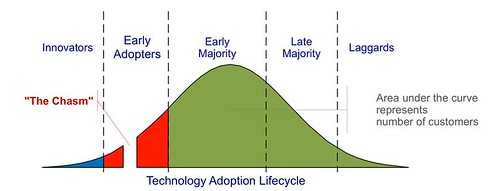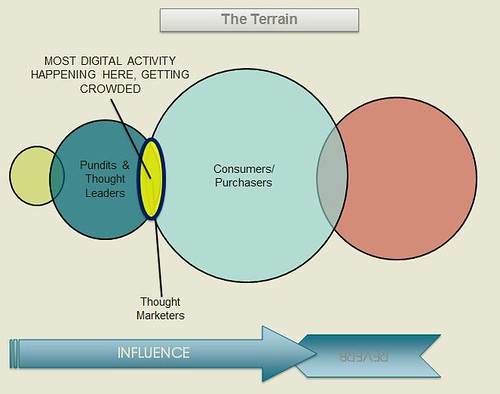(This post was inspired by my conversation with Michael Roston of The New York Times. I’m deeply grateful for his insights.)
I’ve been working on a diagram to anchor the digital-strategy conversations I have with clients. I wanted a map of the current landscape to reference when speaking about “why” we need to implement these strategies. Over the past two months, I’ve been sharing this diagram with my peers and refining it down. Then, just when I thought I had created the final version, two peers (Michele Clarke and Natalie Lieblick) noted it was reminiscent of Geoffrey A. Moore’s “Technology Adoption Lifecycle,” which he developed in his book, Crossing the Chasm (1991).
This is true, but instead of it being a bummer, it was a spark of evolution. In comparing my diagram to Moore’s theory, we can specifically identify what’s changed from then to now. Hurrah!
The initial “Chasm” theory points out the hurdle new technology needs to traverse in order to gain widespread adoption. Here’s a diagram that illustrates Moore’s “Chasm” theory:

Over on the left is the Chasm. Moore speculated that somewhere within the early adoption process this Chasm ate up most new technology, with only a few making it to the “Early Majority” market. This symptom still exists, but in our current era the “Early Adopter” zone is populated by a new set of behaviors.
Over the past 20 years, marketers, communications professionals, new technology startups and advertisers have been actively seeking to fix the Chasm. Right now the new fix is You, the digitally connected individual. The cultural forces that impact our lives have us focusing greater and greater time and energy within the online “networking” space. Facebook, Twitter, blogging, etc., have pointed our activity right at the Chasm; we’re reverse-mining the Chasm by filling it up with the immense amount of content we share. While marketers and communication pros used to focus on getting people across the Chasm, the need now is for marketers to minimize the impact of the Chasm, by re-engineering it altogether to make it irrelevant.
In my new map, an evolution from Moore’s theory, I’ve identified the behaviors of the entire terrain. While similar to Moore’s, it includes new overlaps, new definitions and updated behaviors.
The Cultural Terrain:

The Cultural Terrain defines where ideas start (not just technology products), where they are amplified and where they are adopted. From left to right, all of the roles within this Terrain are (I’ve defined each role in more detail at the end of this post):
– Trailblazers
– Futurists
– Pundits & Thought Leaders
– Thought Marketers
– Consumers
– Late Adopter
– Lurkers
In the space where the Chasm used to be, there are now three main behaviors:
– Futurists
– Pundits & Thought Leaders
– Thought Marketers
The new, key re-engineering role is being populated by the “Thought Marketers.” The number of participants within the Thought Market is growing exponentially as anyone with an Internet connection can now partake in the Thought Market. You yourself are probably a Thought Marketer. You don’t have to be “mainstream” to be a Thought Marketer; you can be either a Consumer who is participating within the public dialogue (posting status updates, sharing videos, new links, blogging, etc.) or a Pundit who seeks to influence your thinking. In fact, this influence is now a two-way street. Consumers have greater voice in defining the conversation around ideas, versus 20 years ago when this conversation was more passive.

When I post links to content I’ve found that I want to share with you, I’m Thought Marketing. A friend post photos they want me to see and when brands post messages they want to me act on, they’re Thought Marketing. A journalist shares handheld videos that support their articles, my cousin shares a video of his kids — they are both Thought Marketing.
This behavior has created a new type of ecosystem, mostly seen through the growth of social media, that hopes to create influence through activity (I tweet every day in order to make sure people see my Tweets) and trust (I hope to gain more friends so you want to be my friend too, then I can share my ideas with more people). Thought Marketers are all hoping to inject and amplify their “thoughts” into the conversation to influence the conversation, to gain some recognition and to somehow prosper from their activity. If I share my photo with you, which is seemingly innocent, I am actually making an exchange with you, providing something I believe has value with hopes it influences your life, even modestly with a “like” on Facebook. More friends, more fans, more purchases…more influence.
As more and more people are engaging within the Thought Market, Thought Marketers have to increase their activity in order to gain results. As example, my Facebook news stream is full; I often miss photos my friends are hoping to share with me. I share news items over my Twitter feed — only a small percentage of my friends actually see my Tweet. Still, this activity can be very rewarding; if your message receives a spike in attention, your reach and potential influence can be immense, but it sure does take a lot of time.
Everyone who seeks to influence anyone wants to be in the Thought Market, and social software continues to provide more entry into this zone on the map. The role of the consumer and the marketer is blending as word-of-mouth, bloggers and tech startups continue to fuse these roles together.
So, if it’s getting so crowded in the Thought Market, and it’s taking more and more of my time to be influential there, what’s next?
I’m working on some thoughts right now and will market them to you next week.
——
The Cultural Terrain Roles:
Trailblazers: These are the fiercely innovative individuals and organizations who are inventing the future. Their greatest concerns are for newness and innovation, regardless of monetary rewards or who hears about the technology. They are the true “bleeding”-edge.
Futurists: These folks are the glue between the “bleeding”-edge and the amplification of new trends. They are both pushing the envelope while seeking to communicate their learnings to the larger group. They are aware of the tightrope they walk — knowing they are sharing discoveries that might be “too early” for the popular market but see the deep value these trends will bring to the future.
Pundits & Thought Leaders: This group identifies which of the new trends map to their own agendas and work to configure the trends for either personal or organizational gain. They are reliant on the Futurists to do the initial filtering, but take it the step further to create ingestible, adoptable plans integrating new trends into the lives of their markets and audiences.
Thought Marketers: This is the “stock market” for ideas where thought-brokers seek to amplify key trends, news, stories, etc., to attract Consumers. They aim to craft sticky and compelling content that will either resonate with a current audience or attract a new one. This is the main arena for advertisers, marketers and communicators. The thought market is where nearly all the obvious activity is taking place, primarily through the exponential growth of social media.
Consumers/Purchasers: This is the buying market. The individuals and organization who determine their purchases and take steps to make the new products and trends mainstream.
Late Adopters: These are the late bloomers to a trend. They do eventually get around to purchasing an item but typically long after the marketing campaigns are spent out and Thought Marketers have moved on to a new trend or idea.
Lurkers: This group waits until a trend has passed before they potentially participate. Still, they are a large group with buying power but are the hardest to influence. In Moore’s chart, these are the laggards.
Layered on top of this terrain is the “Popular Scope.” This is the arena at which most of current advertising, PR and marketing campaigns are aimed.
Throughout the timeline is the power of influence. Influence starts with the Trailblazers, moves through to the Consumers, and hits the wall at the Lurkers. Once it hits the wall, influence then reverbs back into the Consumers, typically as kitsch, irony and snark.